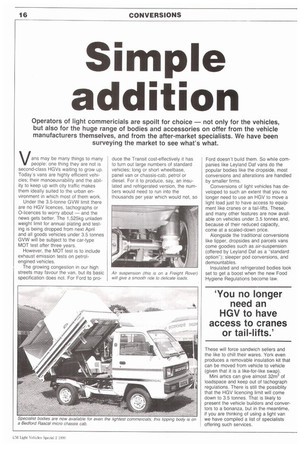Simple addition
Page 100

If you've noticed an error in this article please click here to report it so we can fix it.
Operators of light commericials are spoilt for choice — not only for the vehicles, but also for the huge range of bodies and accessories on offer from the vehicle manufacturers themselves, and from the after-market specialists. We have been surveying the market to see what's what.
Vans may be many things to many people: one thing they are not is second-class HGVs waiting to grow up. Today's vans are highly efficient vehicles; their manoeuvrability and the ability to keep up with city traffic makes them ideally suited to the urban environment in which most of them work.
Under the 3.5-tonne GVW limit there are no HGV licences, tachographs or 0-licences to worry about — and the news gets better. The 1.525kg unladen weight limit for annual plating and testing is being dropped from next April and all goods vehicles under 3.5 tonnes GVW will be subject to the car-type MOT test after three years.
However. the MOT test is to include exhaust emission tests on petrolengined vehicles.
The growing congestion in our high streets may favour the van, but its basic specification does not. For Ford to pro duce the Transit cost-effectively it has to turn out large numbers of standard vehicles; long or short wheelbase, panel van or chassis-cab, petrol or diesel. For it to produce, say, an insulated and refrigerated version, the numbers would need to run into the thousands per year which would not, so Ford doesn't build them. So while companies like Leyland Daf vans do the popular bodies like the dropside, most conversions and alterations are handled by smaller firms.
Conversions of light vehicles has developed to such an extent that you no longer need to use an HGV to move a light load just to have access to equipment like cranes or a tail-lifts. These, and many other features are now available on vehicles under 3.5 tonnes and, because of their reduced capacity, come at a scaled-down price.
Alongside the traditional conversions like tipper, dropsides and parcels vans come goodies such as air-suspension (offered by Leyland Daf as a "standard option"); sleeper pod conversions, and demountables.
Insulated and refrigerated bodies look set to get a boost when the new Food Hygiene Regulations become law.
These will force sandwich sellers and the like to chill their wares. York even produces a removable insulation kit that can be moved from vehicle to vehicle (given that it is a like-for-like swap).
Mini artics can give almost 32e of loadspace and keep out of tachograph regulations. There is still the possiblity that the HGV licencing limit will come down to 3.5 tonnes. That is likely to present the vehicle builders and convertors to a bonanza, but in the meantime, if you are thinking of using a light van we have compiled a list of specialists offering such services.
















































































































